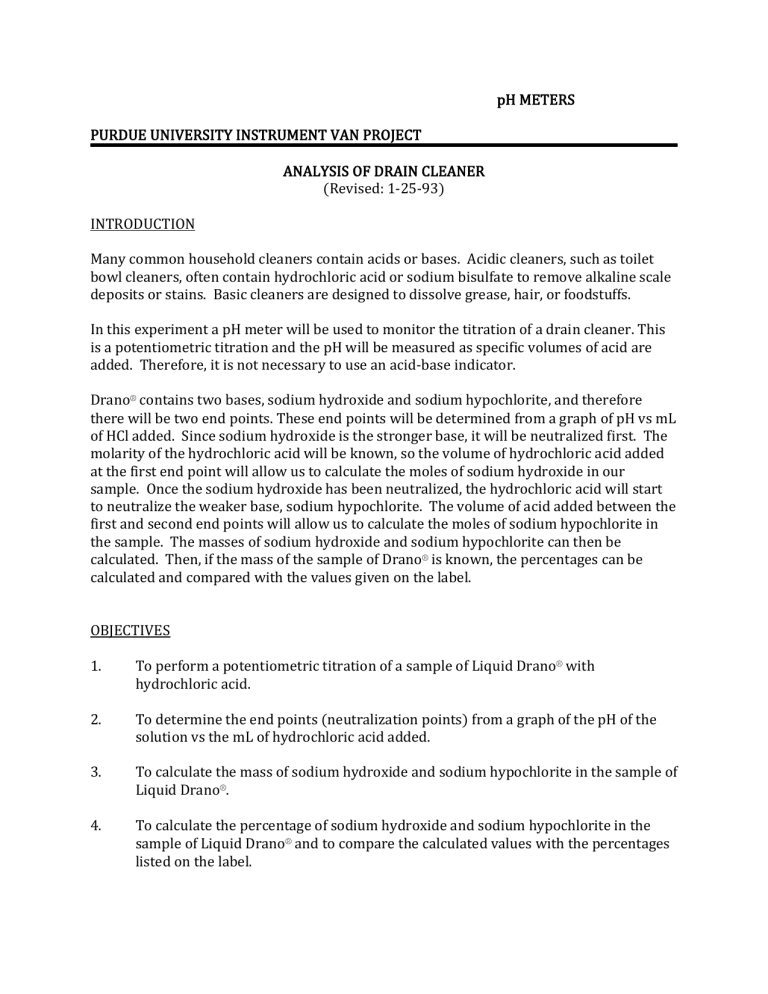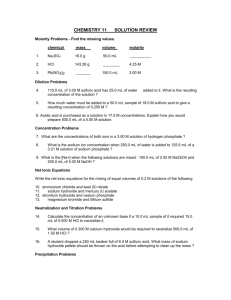
pH METERS PURDUE UNIVERSITY INSTRUMENT VAN PROJECT ANALYSIS OF DRAIN CLEANER (Revised: 1-25-93) INTRODUCTION Many common household cleaners contain acids or bases. Acidic cleaners, such as toilet bowl cleaners, often contain hydrochloric acid or sodium bisulfate to remove alkaline scale deposits or stains. Basic cleaners are designed to dissolve grease, hair, or foodstuffs. In this experiment a pH meter will be used to monitor the titration of a drain cleaner. This is a potentiometric titration and the pH will be measured as specific volumes of acid are added. Therefore, it is not necessary to use an acid-base indicator. Drano® contains two bases, sodium hydroxide and sodium hypochlorite, and therefore there will be two end points. These end points will be determined from a graph of pH vs mL of HCl added. Since sodium hydroxide is the stronger base, it will be neutralized first. The molarity of the hydrochloric acid will be known, so the volume of hydrochloric acid added at the first end point will allow us to calculate the moles of sodium hydroxide in our sample. Once the sodium hydroxide has been neutralized, the hydrochloric acid will start to neutralize the weaker base, sodium hypochlorite. The volume of acid added between the first and second end points will allow us to calculate the moles of sodium hypochlorite in the sample. The masses of sodium hydroxide and sodium hypochlorite can then be calculated. Then, if the mass of the sample of Drano® is known, the percentages can be calculated and compared with the values given on the label. OBJECTIVES 1. To perform a potentiometric titration of a sample of Liquid Drano® with hydrochloric acid. 2. To determine the end points (neutralization points) from a graph of the pH of the solution vs the mL of hydrochloric acid added. 3. To calculate the mass of sodium hydroxide and sodium hypochlorite in the sample of Liquid Drano®. 4. To calculate the percentage of sodium hydroxide and sodium hypochlorite in the sample of Liquid Drano® and to compare the calculated values with the percentages listed on the label. pH METERS PURDUE UNIVERSITY INSTRUMENT VAN PROJECT SAFETY 1. Wear your goggles and apron at all times during this experiment. 2. Liquid Drano® contains strong base. If any of the material is spilled, notify your teacher so that it can be cleaned up as soon as possible. 3. Follow the other standard safety procedures as explained by your teacher. MATERIALS Liquid Drano® distilled water 50 mL buret balance 10 mL graduated cylinder pH meter 0.10 M HCl 250 mL beaker 2 other beakers for solutions magnetic stirrer and stirring bar PROCEDURE 1. Obtain about 100 mL of 0.10 M HCl in a clean, dry beaker. This beaker should be labeled. Never pour any solution back into this beaker. Once the solution has been poured into the buret, it should be discarded into the sink or waste container. 2. Rinse your buret with distilled water. Then use a small amount of the 0.l0 M HCl solution to rinse the buret. (Pour about 10 ml of the HCl solution into the buret. Let some of it flow through the tip. Pour the rest of the HCl solution out the top of the buret, rotating the buret as you pour.) The rinsing solution should be discarded into the sink. Repeat this rinsing procedure twice more. Fill the buret to some point higher than the markings with the HCl solution and then carefully let the HCl solution out into a waste container until the bottom of the meniscus is on the 0.00 line. 3. Standardize the pH meter (Refer to the specific instructions for the pH meter that you will be using) 3. Determine the mass of a clean, dry 250 mL beaker and record this mass in your data table. Using a 10 mL graduated cylinder measure out approximately 3 mL of Liquid Drano® and add it to the beaker. Determine the mass of the beaker with the Liquid 2 pH METERS PURDUE UNIVERSITY INSTRUMENT VAN PROJECT Drano® and record this mass in your data table. 4. Add about 75 mL of distilled water to the beaker with the Liquid Drano®. Carefully drop in a magnetic stirring bar. Set the beaker on the magnetic stirring motor and position the buret and pH electrode as shown in the diagram. Carefully turn on the stirring motor and make sure that the stirring bar does not hit the electrode. Adjust the stirring speed as directed by your teacher. 5. Set up your data table to include mL of HCl added and the pH of the solution. You should allow for as many as 50 mL of solution. 6. Measure and record the pH of the solution before any HCl has been added. 7. Add 1.0 mL of HCl solution carefully from the buret. Record the pH when it has stabilized. Add another 1.0 mL of HCl and record the pH. Continue adding HCl in 1.0 mL increments until you have obtained a pH reading less than 3.5. If you get to 50 mL, carefully refill the buret. 8. Remove the pH electrode from the solution, rinse it with distilled water, and store it as directed by your teacher. 9. The solutions may be discarded down the sink. Rinse the buret with distilled water and place it upside down in the buret holder to drain. CALCULATIONS 3 pH METERS PURDUE UNIVERSITY INSTRUMENT VAN PROJECT 1. Make a graph of the pH vs mL of HCl added. The pH should be on the vertical axis and the mL of HCl should be on the horizontal axis. The graph should be of such a size that 1 mL is represented by 1 square on the graph and the pH scale is spread out as much as possible. 2. Determine the end points of the titration. There should be two regions on your graph where the slope changes rapidly. The end point is the midpoint of the region. Since sodium hydroxide is the stronger base, it is neutralized at the first end point. Then sodium hypochlorite, the weaker base, is neutralized at the second end point. Determine the number of mL of HCl required to neutralize the sodium hydroxide and the number of mL of HCl required to neutralize the sodium hypochlorite. Remember that the sodium hypochlorite is not neutralized until after all the sodium hydroxide, so the mL of HCl required will be the difference in the two end points. 3. Calculate the number of moles and then the mass of sodium hydroxide, NaOH, and sodium hypochlorite, NaOCl, present in your titrated sample. 4. Calculate the mass percent of sodium hydroxide and sodium hypochlorite in your titrated sample. 5. Record the percentages of sodium hydroxide and sodium hypochlorite from the label on the Liquid Drano® container. 6. Calculate the percent difference for each of these substances. LAB WRITTEN BY: PRU PHILLIPS 4 pH METERS PURDUE UNIVERSITY INSTRUMENT VAN PROJECT TEACHERS' GUIDE ANALYSIS OF DRAIN CLEANER CLASSROOM USAGE This experiment should not be used as an introduction to titration, and is, therefore, probably more appropriate for a second year course. CURRICULUM INTEGRATION Acid, base and pH Stoichiometry PREVIOUS KNOWLEDGE Titration Stoichiometry Acid, Base and pH TIME The titration itself has to be done in one day. There is no way to stop in the middle of the titration and pick up where you left off. If students are not familiar with the set-up and procedure, another class period should be provided for practice. PREPARATION You, the teacher, need to provide the buffer solutions for standardization of the pH meter. The titration goes from pH 13 to pH 4. Buffer pH 7 has to be used. Buffer pH 10 would be good for the second one, although buffer pH 4 would also work. .10 M HCl (8.5 mL of concentrated (12 M) HCl per liter) Each group of students will need about 150 mL SAFETY AND DISPOSAL 5 pH METERS PURDUE UNIVERSITY INSTRUMENT VAN PROJECT Standard safety procedure should be followed. Students should wear goggles and aprons. All materials may be disposed of by pouring down the drain with water. SAMPLE DATA Mass of 250 mL beaker: Mass of beaker and Liquid Drano®: 105.48 g 108.88 g Mass of Liquid Drano® titrated: 3.40 g mL HCl added pH 0 1 2 3 4 5 6 7 8 9 10 11 12 13 14 15 16 mL HCl added pH 13.85 13.81 13.75 13.66 13.56 13.42 13.21 12.85 12.48 12.06 11.67 11.30 10.96 10.58 10.22 10.00 9.77 17 18 19 20 21 22 23 24 25 26 27 28 29 30 31 32 33 6 9.59 9.48 9.38 9.28 9.20 9.10 9.02 8.93 8.86 8.78 8.72 8.65 8.57 8.49 8.41 8.32 8.23 pH METERS PURDUE UNIVERSITY INSTRUMENT VAN PROJECT mL HCl added pH 34 35 36 37 38 39 40 41 42 43 44 45 46 47 48 49 50 8.13 8.01 7.88 7.70 7.46 7.03 5.71 4.91 4.33 4.14 4.03 3.90 3.81 3.73 3.66 3.61 3.57 SAMPLE CALCULATIONS 1. End Point #1 (NaOH) End Point #2 (NaOCl) 10 mL of HCl added 40 mL of HCl added mL of HCl required to neutralize the NaOH: 10 mL mL of HCl required to neutralize the NaOCl: 40 - 10 = 30 mL 2. Determination of the mass of sodium hydroxide in the titrated sample: 10 mL H + x 1 L H+ 0.10 moles H + 1 mole NaOH 40 g NaOH x x x = 0.040 g NaOH 1000 mL H + 1 L H+ 1 mole H + 1 mole Determination of the mass of sodium hypochlorite in the titrated sample: 7 pH METERS PURDUE UNIVERSITY INSTRUMENT VAN PROJECT 30 mL H + x 3. 1 L H+ 0.10 moles H + 1 mole NaOCl 74.5 g NaOCl x x x = 0.223 g NaOCl 1000 mL H + 1 L H+ 1 mole H + 1 mole NaOCl Mass percent of sodium hydroxide in the titrated sample: 0.040 g NaOH x 100 = 1.2% NaOH 3.40 g sample Mass percent of sodium hypochlorite in the titrated sample: 0.223 g NaOCl x 100 = 6.55% NaOCl 3.40 g sample 4. Percentages listed on the bottle of Liquid Drano®: 2.4 % sodium hydroxide 5. 6 % sodium hypochlorite Percent Differences 2.4 1.2 x 100 = 50% 2.4 sodium hydroxide: 6.55 6.0 x 100 = 9.2% 6.0 sodium hypochlorite: Comment: This is actual student data from an initial run for this experiment. It was disappointing that the first end point wasn't sharper because it was difficult to determine the mid point of the segment. Nevertheless this is a good experiment and is one worth doing. 8 pH METERS PURDUE UNIVERSITY INSTRUMENT VAN PROJECT REFERENCE Central Pennsylvania Association of Chemistry Teachers in Cooperation with NSF, Juniata College, and Private Industry. (1990). Student Laboratory Instrumentation Manual for Excellence. 9







